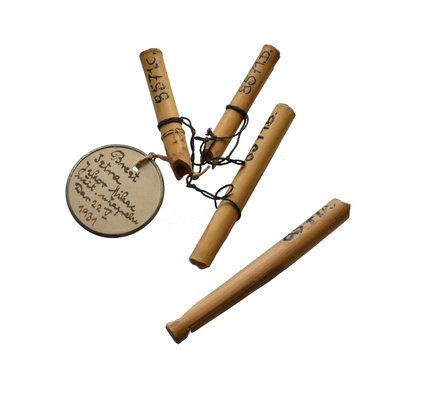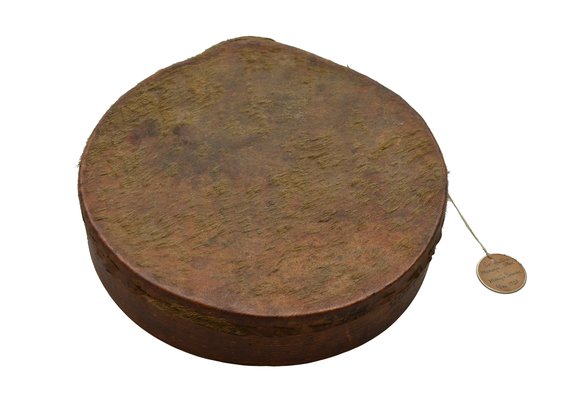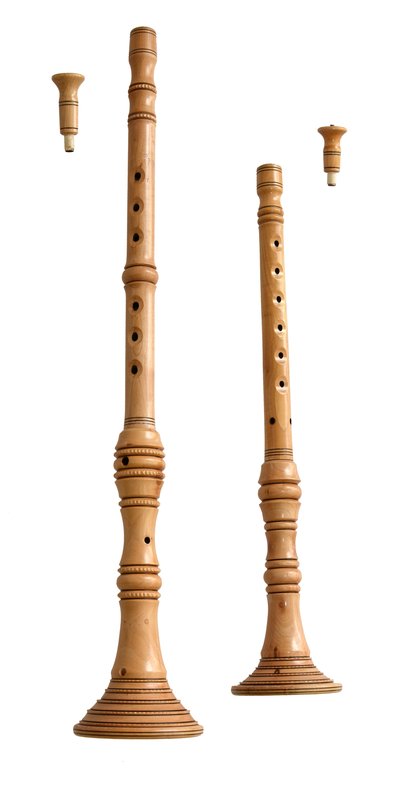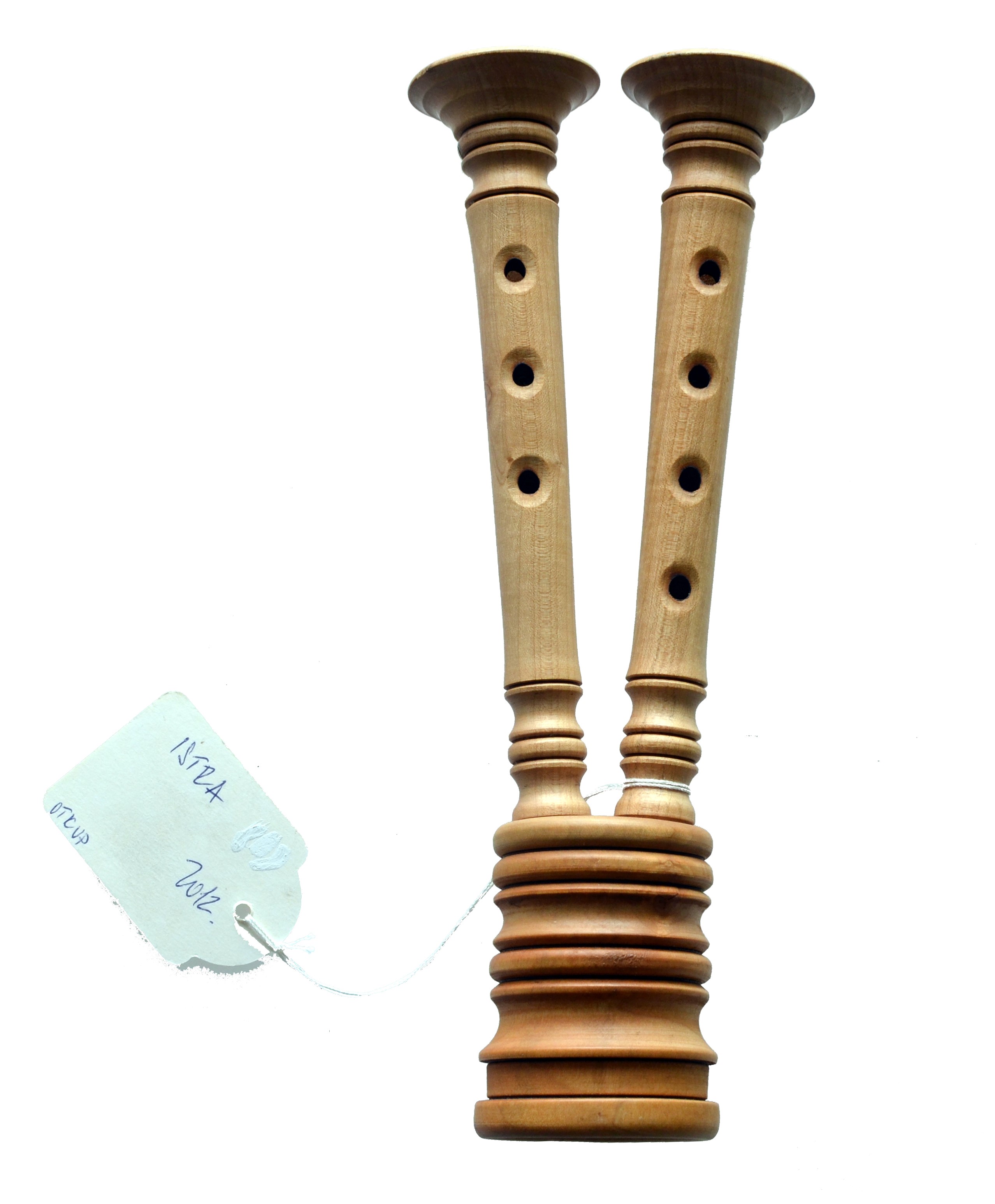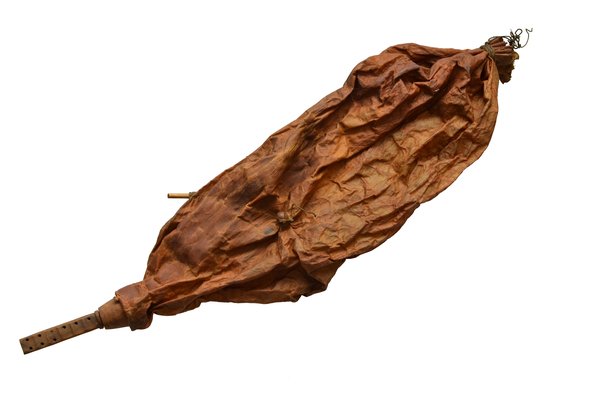-
Tambourine EMZ-2765
Zbirka: Ethnographic Museum, ZagrebNepoznat
oko/cca 1920.Wood, Skin, Hand made
d (diameter)=23 cm
The tambourine is made of one hoop of the old sieve. The skin is probably of a sheep. The hoop is connected with small nails and wire. It is slightly damaged. The skin is tied to the hoop with a rope. The hair of the skin was not completely removed. The tambourine was used primary for playing on occasions of celebrations and later for mushrooms hunting. On the inventory tag it is written: „Sv. Antun, Medveja, Istra Marija Domac, 1923“.
-
Great and small sopela EMZ-48107
Zbirka: Ethnographic Museum, ZagrebDarko Vitasović
2011. , Boduleri (Vodnjan)Wood, Maple, Woodturning, Carving
great A=595 E1=140 E5=30 E9= / B=50 E2=26 E6=30 E10= / C=100 E3=30 E7=75 F=5 D=24 E4=60 E8=65 small A=455 E1=75 E5=25 E9= / B=40 E2=25 E6=25 E7-E10=90 C=90 E3=25 E7=30 F=4 D=22 E4=25 E8= / Great: The instrument has six finger-holes . The bell has two vent-holes and one of them is drilled through the pipe on both sides. The sopela is decorated with ridges and grooves made on a lathe and parallel rings made with an incandescent wire also with the help of a lathe. In addition, the bell also has carved jagged decorations. The initials of the maker – DV (Darko Vitasović) – made with an incandescent wire are inside the bell. The instrument is lacquered with transparent varnish. The reed and the wooden stop on the pirouette are missing. (Note: the instrument was exposed at the exhibition Croatian Intangible Cultural Heritage on UNESCO list, 30.09.2015.)
Small:The instrument has seven finger-holes on the pipe and the seventh hole (for the little finger) is double. The bell has a vent-hole drilled on both sides. The sopela is decorated with ridges and grooves made on a lathe and parallel rings made with an incandescent wire also with the help of a lathe. In addition to parallel rings made on a lathe the bell also has carved jagged decorations. The instrument is lacquered with transparent varnish. The reed on the pirouette is missing. (Note: the instrument was exposed at the exhibition Croatian Intangible Cultural Heritage on UNESCO list, 30.09.2015.) -
Šurle EMZ-48546
Zbirka: Ethnographic Museum, ZagrebNepoznat
oko/cca 1970Wood, Woodturning
chanter stock reeds A=170 E1=65 F=6 H=58 d1=52 B=22 E2=20 G=4 I=44 Ø1=6 C1=28 E3=20 J=41 d2=52 C2=15 E4=22 Ø2=6 D=11 The right pipe of the instrument has four holes, and the left one three. The pipes are decorated with parallel rings made with an incandescent wire on a lathe. The stock also has ring ornaments, and protrusions and grooves made on a lathe. The instrument is lacquered with transparent varnish. The bottom of the pipes is enlarged in conical shape. The instrument was acquired in Motovun in 1972 on a local fair. Fedor (or Ferdo) Kritovac bought and used this instrument.
-
Mišnice with the bag EMZ-8183
Zbirka: Ethnographic Museum, ZagrebNepoznat
2.pol 19. st./2nda meta' 19. sec/2nd half 19th cent..Wood, Skin, Hand made, Carving
chanter stock reeds A=130 E1=30 E6=17 H=60 d1= 55 B=15 E2=18 E7= / I=? Ø1= 7 C1=22 E3=18 F=5,3 J=33 d2= 49 C2=27 E4=18 G=3,8 Ø2= 7,4 D=21 E5=18 The instrument has a standard number and arrangement of finger-holes. The chanter is handmade. There are no particular decorations on the instrument, except a fake fingerhole on the chanter. The bag is tied on the back with a tiny waxed rope. The stock is tied to the bag from inside, like one leg. The blowpipe is made of cane and tied from outside the bag. In some places the bag is sewed. On the inventory tag it is written: „Brest, Istra, Jakov Mikac, 16.1.1931. “
